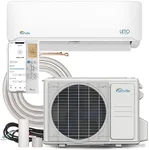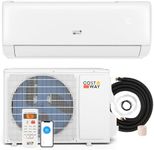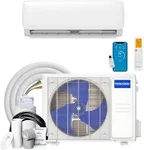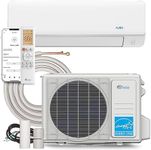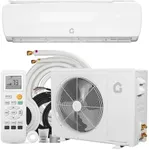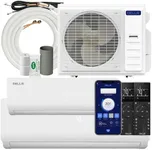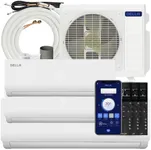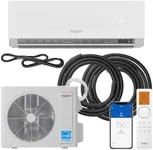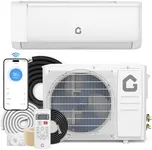Buying Guide for the Best Mini Splits
When shopping for a mini-split system, you want to make sure the unit will efficiently heat or cool your space, fit within your home's layout, and be easy to operate over time. Mini-splits are a popular choice because they allow for targeted temperature control without the need for ductwork. Picking the right one involves understanding a few essential features and specs, which help determine how well a system will work for your needs. Thinking about the size of the area you want to control, noise preferences, and energy usage will guide your decision and ensure your comfort.BTU (British Thermal Units)BTU is a measure of cooling or heating capacity. The higher the BTU, the more powerful the mini-split, which means it can handle larger rooms or spaces with more challenging climates. Small spaces, such as bedrooms or offices, typically need a lower BTU rating (around 9000 to 12000), while larger living areas or open spaces may need ratings of 18000, 24000, or more. It's important to match the BTU rating to your room size; a system that's too powerful can lead to rapid temperature changes and humidity issues, while one that's too weak will struggle to keep up. Measure your space and consult general BTU guidelines to land on a rating that matches your room’s size and insulation.
Number of ZonesThe number of zones tells you how many separate areas or rooms the mini-split can control independently. Single-zone models are great for targeting one area, while multi-zone systems allow you to manage climate in several rooms with individual units and controls. Choose based on whether you want to heat or cool just one room or several, as each zone requires its own indoor unit. Consider your living arrangement and whether different family members prefer varying temperatures in their own spaces.
SEER (Seasonal Energy Efficiency Ratio)SEER measures how efficiently the mini-split uses electricity while cooling. Higher SEER ratings mean more energy savings over time. Units typically range from around 13 (basic efficiency) to over 20 (high efficiency). If you expect to run your system often or live in an area with hot summers, a higher SEER can save you money on electricity. For occasional use or mild climates, a mid-range SEER can be sufficient. Think about your expected usage and electric costs to decide what efficiency makes sense for you.
Noise LevelNoise level tells you how loud the indoor and outdoor units will be when running. Measured in decibels (dB), lower numbers mean quieter operation. Quiet systems (below 25 dB indoors) are ideal for bedrooms or study rooms, while slightly higher levels may be acceptable in kitchens or living rooms. If you’re sensitive to background noise or planning to use the system in quiet areas, look for models with the lowest noise ratings.
Installation TypeMini-splits are available as wall-mounted, floor-mounted, or ceiling cassette units. Wall-mounted is most common and works well for most rooms. Floor-mounted can fit under windows, and ceiling cassettes are suited for larger, open areas. The choice depends on room shape, available wall space, and aesthetic preferences. Review your room's layout and furniture to see which setup will be the least intrusive and easiest to maintain.
Heating CapabilitySome mini-splits offer both heating and cooling, using what’s called a heat pump, while others may only cool. If you live in a climate with cold winters, look for models designed for efficient heating at low outdoor temperatures. If heating is only occasionally needed, basic models may suffice. Think about your weather patterns and whether you want one unit to handle all your temperature control needs year-round.
Smart FeaturesModern mini-splits may include smart controls, such as Wi-Fi connectivity for smartphone apps, programmable timers, or voice assistant compatibility. These features can make it easier to manage your climate remotely, set schedules, and save energy. If convenience and automation matter to you, or if you travel often, smart features can add significant value. If you prefer to keep things simple, basic remote controls are often enough.
